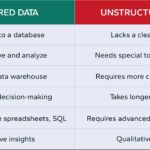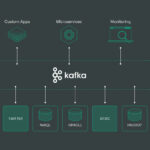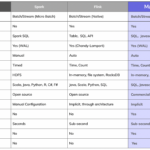In the realm of Big Data, the sheer volume and complexity of data make it crucial to have a comprehensive understanding of where data comes from, how it is transformed, and where it flows throughout the entire data processing pipeline. This process is known as data lineage tracking, and it plays a vital role in ensuring data accuracy, reliability, and compliance in Big Data environments. By tracing the lineage of data from its origin to its destination, organizations can effectively manage data quality, troubleshoot issues, and meet regulatory requirements. In this fast-paced world of Big Data, data lineage tracking serves as a fundamental pillar in establishing trust, transparency, and accountability in data-driven decision-making processes.
In the rapidly evolving landscape of Big Data, organizations are generating and consuming vast amounts of information daily. Understanding the flow of data—from its origin to its current state—is crucial. This is where data lineage tracking comes into play. This article delves into the significance of data lineage tracking within the context of Big Data, exploring its benefits, methodologies, and challenges.
What is Data Lineage?
Data lineage refers to the tracking and visualization of the lifecycle of data as it moves through an organization. It illustrates how data is created, transformed, and ultimately consumed. With Big Data frameworks such as Hadoop, Spark, and others being utilized, data becomes complex, necessitating robust lineage tracking for effective management.
Why is Data Lineage Tracking Crucial in Big Data?
1. Enhanced Data Governance
Data governance is crucial for any organization that deals with large datasets. Effective data lineage tracking enables companies to establish clear policies and compliance demands for data handling. Regulatory requirements, such as the GDPR and CCPA, necessitate organizations to know the source and transformation of data to ensure compliance. Without proper lineage tracking, businesses can face hefty fines and reputational damage.
2. Improved Data Quality
Data quality remains a crucial aspect of Big Data analytics. By tracking data lineage, organizations can identify any data inconsistencies, duplicates, or anomalies throughout its journey. This helps in establishing data profiles, ensuring that high-quality datasets feed into analytics processes. The result is improved business insights and better decision-making.
3. Root Cause Analysis
When issues arise in data analytics processes or reports, understanding the root cause is vital. Data lineage tracking provides a historical view of how data has been processed and transformed. This transparency allows data engineers and analysts to quickly pinpoint where errors have occurred, facilitating faster resolutions and minimal downtime.
4. Data Security and Access Controls
Security concerns are more prominent in the Big Data landscape due to the variety and volume of data. Data lineage tracking supports organizations in mapping data flow and identifying who accessed it at various stages. This visibility can help in enforcing access controls and auditing actions within the data lifecycle, ensuring that sensitive information remains protected.
5. Facilitating Data Traceability
Data traceability is the ability to trace the origin and transformation of data through various systems. In Big Data environments, systems typically integrate multiple data sources and types. Data lineage tracking provides comprehensive insights into how data has been interlinked, enabling organizations to maintain an accurate history of data movement and transformations.
How to Implement Data Lineage Tracking?
1. Metadata Management
Metadata serves as the backbone for data lineage tracking. It encompasses all data properties, including origin, format, structure, and relationships with other datasets. Effective metadata management systems enable organizations to collect, store, and analyze metadata seamlessly, laying the groundwork for robust lineage tracking.
2. Automated Lineage Tools
Modern automated lineage tracking tools streamline the process, capturing data flow in real-time. Tools like Apache Atlas, AWS Glue, and Talend ensure that every transformation and lineage graph gets recorded automatically without manual input. Automation reduces human error and enhances accuracy in data lineage tracking.
3. Visualization Techniques
Effective visualization aids in understanding complex data lineage. Many tools provide digestible visual representations of data flow, making it easier for non-technical stakeholders to grasp the lifecycle of data. Monitoring dashboards and lineage graphs assist in quickly identifying where issues may arise and can promote better communication across teams.
4. Regular Audits and Reviews
Implementing data lineage tracking is not a one-time effort. Organizations need to conduct regular audits and reviews of their lineage tracking systems to ensure accuracy and comprehensiveness. This allows organizations to update lineage information regularly and adapt to changes in data sources or processing components.
Challenges in Data Lineage Tracking
1. Complexity of Data Ecosystems
As organizations adopt a myriad of tools and platforms for data processing, the complexity of the data ecosystem increases. Diverse systems may have different definitions of lineage, leading to inconsistencies. Organizations must navigate these complexities to establish a unified lineage framework that encompasses all data sources.
2. Inconsistent Data Standards
Inconsistent data standards across systems can complicate data lineage tracking. Without standardized definitions for data attributes and relationships, it becomes challenging to track the lineage accurately. Organizations need to enforce data governance policies that establish common data definitions across departments.
3. Change Management
As data systems evolve, changes in infrastructure or processes can disrupt existing lineage tracking. Organizations must adopt a proactive change management approach to update lineage records continuously. Implementing version control and change logs can mitigate these disruptions.
The Future of Data Lineage Tracking
The future of data lineage tracking in Big Data appears promising with advancements in technology. The evolution of artificial intelligence (AI) and machine learning (ML) offers exciting possibilities for automating and enhancing data lineage tracking systems. AI can analyze historical data flows, recognize patterns, and predict where lineage changes may happen, thus increasing efficiency.
Furthermore, the increasing emphasis on data privacy and protection will further solidify the need for data lineage tracking. Organizations will be able to leverage lineage tracking to sustain compliance with evolving regulations and maintain investor and customer trust.
Conclusion
Data lineage tracking is no longer a luxury; it has become an essential component of a robust Big Data strategy. From enhancing data governance to improving data quality, the benefits of meticulous lineage tracking are undeniable. By understanding the importance and implementing an effective data lineage tracking strategy, organizations can navigate the complexities of Big Data and make informed, data-driven decisions.
The effective tracking of data lineage is vital in the realm of Big Data to ensure transparency, trustworthiness, and ease of data management. By clearly understanding the origins and transformations of data, organizations can make informed decisions, maintain data quality, comply with regulations, and enhance overall data governance practices. As Big Data continues to evolve and grow in complexity, implementing robust data lineage tracking mechanisms will be indispensable for maximizing the value and utility of data assets.













